Guide to Detecting Counterfeit Indonesian Rupiah (IDR) Banknotes
Exchange Foreign Currency Now
How to Identify Counterfeit Indonesian Rupiah (Rp) Currency Notes
When traveling from India to Indonesia, carrying Indonesian rupiah (IDR) is essential, but understanding the currency is just as important. While fake rupiah notes are relatively rare, being able to recognize genuine bills can protect you from potential issues, especially when exchanging money in crowded markets or local stores. With this guide, you can easily tell the difference between a real Indonesian Rupiah and a fake one at a glance.
Key Security Features of Indonesian Rupiah Bank Notes
Paper Quality and Texture:
Genuine Rupiah banknotes are printed on a special type of paper primarily made from cotton fiber. This material gives the banknotes a crisp and resilient feel, with a slightly rough texture. This is different from ordinary commercial paper, which tends to be smoother, flimsier, or waxy.
Watermark and Electrotype:
A watermark is a faint image, typically of a national hero, that is embedded within the paper structure during its manufacturing process. It is visible when the banknote is held up to a light source. An electrotype is a variant of the watermark that often appears lighter and with more defined details, commonly displaying the denomination numeral or the Bank Indonesia (BI) logo.
Security Threads:
These are thin threads that are either fully embedded within the banknote paper or woven into it. Security threads can vary in appearance; some are simple, while others may contain microprinting (miniature text), change color when the note is tilted, or exhibit holographic effects.
Intaglio Printing:
Intaglio is a specialized printing process that deposits a thick layer of ink on the paper, creating a raised texture that can be felt by touch. On genuine Rupiah banknotes, intaglio printing is used for key elements such as the main portrait of the national hero, the denomination numerals, the Garuda Pancasila (national emblem), and the phrase "BANK INDONESIA".

See-Through Register:
This feature consists of an image or design element that is printed in separate halves on the front and back of the banknote. When the note is held up to the light, these halves align perfectly to form a complete, coherent image. Commonly, this feature forms the Bank Indonesia (BI) logo.
Color-Shifting Ink and Iridescent Stripes:
Some denominations of the Indonesian Rupiah, particularly the higher ones like the 50,000 and 100,000 Rupiah notes, incorporate color-shifting inks and iridescent stripes. These features change color when the note is tilted, adding an additional layer of security that's difficult to replicate.
Ultraviolet (UV) Features:
Under UV light, authentic Rupiah notes reveal specific features not visible under normal lighting conditions. These can include fluorescent fibers embedded in the paper, glowing patterns, or denomination indicators that fluoresce, providing a quick method for verification using UV light sources.
Optically Variable Magnetic Ink:
The Indonesian Rupiah banknotes incorporate advanced security features to deter counterfeiting, one of which is the use of Optically Variable Magnetic Ink (OVMI), commercially known as SPARK®. This technology is particularly evident in higher denominations such as the Rp 50,000 and Rp 100,000 notes.
A Detailed Guide to Identifying Counterfeit IDR Currency by Denomination
| Denomination | Watermark & Electrotype | Security Thread | Intaglio Printing (Raised Feel) | See-through Register | UV Features | Color-shifting Ink & Iridescence | Optically Variable Magnetic Ink (OVMI) |
|---|---|---|---|---|---|---|---|
| Rp 1,000 | Tjut Meutia & “1000” | Embedded, no inscriptions | Portrait, denomination, “BANK INDONESIA” | BI logo when aligned | Fluorescent patterns & hidden denomination indicators | No | No |
| Rp 2,000 | Mohammad Husni Thamrin & “2000” | Plain vertical thread | Portrait & “BANK INDONESIA” | BI logo when aligned | Fluorescent fibers & printed patterns near the denomination box | No | No |
| Rp 5,000 | Idham Chalid & “5000” | Fully embedded, no microprinting | Portrait, denomination, Garuda Pancasila emblem | BI logo when aligned | Scattered fluorescent fibers & glowing denomination numbers | No | No |
| Rp 10,000 | Sultan Mahmud Badaruddin II & “10,000” | Embedded, may include microprinting | Portrait, denomination, Garuda Pancasila emblem | BI logo when aligned | Fluorescent fibers & glowing denomination indicators | No | No |
| Rp 20,000 | Oto Iskandar di Nata & “20,000” | Embedded with microprinting, slight color shift | Portrait, denomination, Garuda Pancasila emblem | BI logo when aligned | Scattered fluorescent fibers & bright denomination indicators | No | No |
| Rp 50,000 | I Gusti Ngurah Rai & “50,000” | Embedded with microtext, noticeable color shift | Portrait, denomination, Garuda Pancasila emblem | BI logo when aligned | Fluorescent fibers & glowing denomination numbers | Yes (color-shifting ink & iridescent stripes) | Yes (OVMI applied on denomination numerals & design elements) |
| Rp 100,000 | Soekarno & Mohammad Hatta & “100,000” | Microprinting & strong color-shifting thread | Portraits, denomination, Garuda Pancasila emblem | BI logo when aligned | Bright fluorescent fibers, glowing marks & unique UV patterns | Yes (color-shifting ink & iridescent stripes) | Yes (OVMI applied on denomination numerals & decorative elements) |

1. Rp 1000
- The Rp1,000 banknote is printed on high-quality cotton fiber paper, which gives it a crisp feel and slightly rough texture.
- It contains a watermark of national hero Tjut Meutia and an electrotype displaying the number "1000," both of which become visible when the note is held up to light.
- A security thread is embedded in the paper, although it doesn't contain inscriptions.
- The main portrait, denomination numerals, and the words "BANK INDONESIA" are printed using intaglio printing, which can be felt by touch.
- The see-through register forms a complete Bank Indonesia (BI) logo when the front and back patterns are aligned under light.
- Under ultraviolet light, certain areas of the note glow, including fluorescent patterns and hidden denomination indicators.
- The Rp1,000 banknote does not feature color-shifting ink. This advanced security feature is typically reserved for higher denominations.
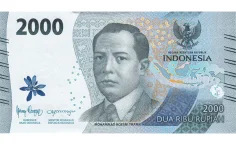
2. Rp 2000
- The Rp 2000 note is printed on cotton-based paper that feels sturdy and textured.
- A watermark of Mohammad Husni Thamrin appears when the note is held to the light, along with an electrotype showing the numeral “2000.”
- A security thread is embedded vertically, but it is plain and does not exhibit dynamic effects.
- Intaglio printing gives raised texture to the main portrait and inscriptions like “BANK INDONESIA.
- A perfectly aligned see-through register of the BI logo appears when viewed against light.
- Under UV light, both fluorescent fibers and printed patterns glow, especially around the denomination box.
- This note does not contain color-shifting ink or iridescent elements.
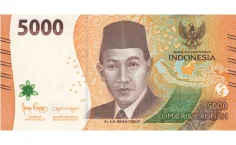
3. Rp 5000
- The Rp 5,000 note is made from high-quality cotton fiber paper, giving it a firm yet slightly textured feel that is crisp to the touch.
- When held up to the light, a clear watermark of national hero Idham Chalid becomes visible, along with an electrotype displaying the number “5000” embedded within the paper.
- The note includes a security thread fully embedded in the paper, though it does not feature microprinting or holographic effects.
- Intaglio printing is used for the main portrait of Idham Chalid, the denomination numerals, and the Garuda Pancasila emblem, creating a raised texture that can be felt easily by running your fingers over these areas.
- The see-through register on the note forms a precise Bank Indonesia (BI) logo when the front and back patterns are aligned under light.
- Under ultraviolet (UV) light, the Rp 5,000 note reveals scattered fluorescent fibers embedded in the paper, as well as glowing denomination numbers that aid in quick authenticity checks. Unlike higher denominations, this note does not incorporate color-shifting ink or iridescent stripes.
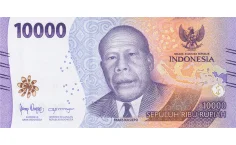
4. Rp 10,000
- The Rp 10,000 banknote is printed on durable cotton fiber paper, giving it a crisp texture with a slightly rough feel typical of genuine Indonesian Rupiah notes.
- When held up to the light, a watermark featuring the national hero Sultan Mahmud Badaruddin II becomes visible, along with an electrotype showing the denomination “10,000.”
- The note contains a security thread embedded within the paper, which may include microprinted text and shift color slightly when tilted, enhancing its security.
- Intaglio printing is used for the main portrait, denomination numerals, and the Garuda Pancasila emblem, giving these elements a raised texture that is easily felt by touch.
- The see-through register aligns perfectly to form the Bank Indonesia (BI) logo when viewed against the light.
- Under ultraviolet (UV) light, fluorescent fibers scattered throughout the note and glowing denomination indicators become visible.
- Unlike the higher denominations, the Rp 10,000 note does not feature color-shifting ink or iridescent stripes.
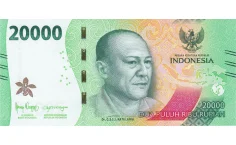
5. Rp 20,000
- The Rp 20,000 note is made from high-quality cotton fiber paper, offering a firm yet slightly textured feel that confirms its authenticity.
- When held up to the light, a clear watermark of the national hero Oto Iskandar di Nata is visible, accompanied by an electrotype displaying the number “20,000.”
- The security thread embedded within the paper contains microprinting and exhibits a slight color shift when tilted.
- Intaglio printing is applied to the portrait, denomination numerals, and the Garuda Pancasila emblem, creating a raised texture that can be felt by touch.
- The see-through register forms a complete and precise Bank Indonesia (BI) logo when the note is held against light.
- Under UV light, scattered fluorescent fibers glow throughout the paper, alongside bright denomination indicators.
- The note does not use color-shifting ink.

6. Rp 50,000
- The Rp 50,000 banknote is printed on sturdy cotton fiber paper, delivering a crisp and slightly coarse texture.
- Holding the note up to light reveals a detailed watermark of the national hero, I Gusti Ngurah Rai and an electrotype showing “50,000.”
- The embedded security thread on this denomination contains microtext and displays a noticeable color shift.
- Intaglio printing provides a raised feel on the portrait, denomination, and the Garuda Pancasila emblem.
- The see-through register forms the Bank Indonesia (BI) logo precisely when aligned.
- Unlike lower denominations, the Rp 50,000 includes color-shifting ink on certain design elements that change color when the note is tilted, adding an extra layer of security.
- Under UV light, fluorescent fibers and glowing denomination numbers appear clearly.
- The note also features iridescent stripes that shimmer when viewed from different angles.
- Another standout feature is the use of Optically Variable Magnetic Ink (OVMI). While this is a highly technical process, it plays a crucial role in preventing counterfeiting. This special ink is applied to key elements such as the denomination numerals and select design elements.
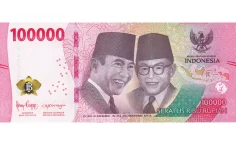
7. Rp 100,000
- The highest denomination currently in circulation, the Rp 100,000 note, is crafted from premium cotton fiber paper with a crisp texture.
- The watermark features the national hero Soekarno and Mohammad Hatta, Indonesia’s founding fathers, with an electrotype displaying “100,000.”
- Its security thread includes microprinting and a strong color-shifting effect visible when the note is tilted.
- Intaglio printing provides a raised texture on the portraits, denomination numerals, and the Garuda Pancasila emblem.
- The see-through register creates a complete Bank Indonesia (BI) logo under light.
- This note prominently uses color-shifting ink and iridescent stripes, which change color and shimmer with movement, making replication extremely difficult.
- When exposed to UV light, the note reveals bright fluorescent fibers, glowing denomination marks, and unique UV patterns invisible to the naked eye under normal lighting.
- This note also features Optically Variable Magnetic Ink (OVMI) on the denomination numerals and decorative elements.


